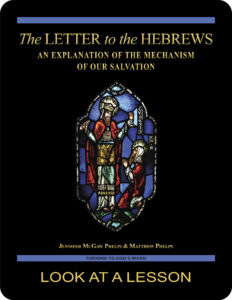safety
 The Book of Jeremiah 33:16 (NABRE) contains a promise of safety and security in the land. It often can seem to us as Christians that such security is impossible. The model of the early Church of suffering and martyrdom for Christ suggests anything but security, and yet this concept is at the heart of Christianity, though instead of safety or security, we use a synonym that has perhaps taken on larger meaning—salvation.
The Book of Jeremiah 33:16 (NABRE) contains a promise of safety and security in the land. It often can seem to us as Christians that such security is impossible. The model of the early Church of suffering and martyrdom for Christ suggests anything but security, and yet this concept is at the heart of Christianity, though instead of safety or security, we use a synonym that has perhaps taken on larger meaning—salvation.
One of the Hebrew words used to refer to safety in the Book of Jeremiah 33:16 (NABRE), יָשַׁע (yasha), is basically synonymous with the Greek σῴζω (sozo), which means “I keep safe” or “I preserve.” Although these two ideas are essentially identical theologically, the Christian connotation that salvation or being saved means “possessing immortal life” has become predominant enough that any previous meaning has been obscured. In the Gospel According to Luke 13:23 (NABRE) and other New Testament passages, sozo shows up in the passive voice and so refers to being safe. In its literal sense, then, being saved is being made safe, the exact prediction of the prophet Jeremiah.
If we’re finally safe in Christ, there must be some danger that otherwise besets us. What do you think that might be? The implicit answer seems to be death that comes from sin. We see that Christian salvation, while it does amount to the common understanding of gaining immortal life, also includes the concept of being kept safe from the danger of death.
related topics: salvation
you also may like our study of the Letter to the Hebrews (digital only)
 Many Christians struggle to understand one of the central mysteries of our faith: how Jesus can be both human and divine at the same time. The Letter to the Hebrews: An Explanation of the Mechanism of Our Salvation, an 18-lesson Catholic Bible study with an imprimatur, offers an in-depth look at the way in which Jesus’ dual nature allows for the salvation of humanity. The Letter to the Hebrews is designed to provide information that will encourage Christians to remain faithful. Click on the book’s cover to view a sample lesson.
Many Christians struggle to understand one of the central mysteries of our faith: how Jesus can be both human and divine at the same time. The Letter to the Hebrews: An Explanation of the Mechanism of Our Salvation, an 18-lesson Catholic Bible study with an imprimatur, offers an in-depth look at the way in which Jesus’ dual nature allows for the salvation of humanity. The Letter to the Hebrews is designed to provide information that will encourage Christians to remain faithful. Click on the book’s cover to view a sample lesson.
 Click on the picture of the statue of Moses with horns (above) to learn more about Lost in Translation. A new entry is archived each Monday. Contact us to receive Lost in Translation by email every week. You may use any of the contact links on our website to ask Matthew a question.
Click on the picture of the statue of Moses with horns (above) to learn more about Lost in Translation. A new entry is archived each Monday. Contact us to receive Lost in Translation by email every week. You may use any of the contact links on our website to ask Matthew a question.
